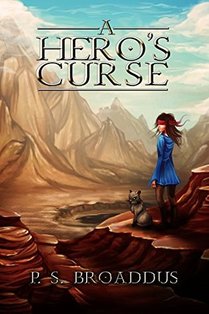
Reviewed for Readers' Favorite at www.ReadersFavorite.com.
*****
The synopsis for A Hero’s Curse, by P. S. Broaddus, intrigued me. To find a fantasy story for young readers with a blind protagonist conjured up all sorts of thoughts and ideas—and Broaddus did not fail to deliver! The story is written from the perspective of Essie, in a manner that allows the reader to join with her in her thoughts. Together with her talking cat, Tig, Essie is left to the care of her Uncle Cagney when her parents must leave for unnamed purposes. But Uncle Cagney’s protection is short-lived. As a result, Essie and Tig (who Essie says is “my friend, my hunting tutor, and most importantly, my eyes”), must flee for safety. They find themselves chased into the Valley of Fire, a place from which no one has ever returned. From there, the two journey to discover what the new leader, Brogan, is up to, why the king disappeared, where Essie’s parents have gone (and why), at whose hand she came to be blind, and whether she will find the means to forgive that person.
I was delighted with Essie’s inner dialog, and with her conversations with her Uncle Cagney, and with Tig. Together they provided insight into the main protagonist. For example, Essie thinks to herself: “I love Tig. He never feels sorry for me, which is great, because I can feel sorry enough for myself.” Later, after a beast chases Essie and Tig, Essie thinks: “It’s one thing to hear monsters bump in the night. It is quite another to never be able to light a lamp to chase them away.” These were the kind of thoughts that made the story so real and so believable. I also enjoyed the bits of insight. Uncle Cagney tells her: “Some people say that there are no heroes in the face of pain. That if the hurt is bad enough, the hero will break. They’re wrong. That’s just what makes a hero. They’re the ones who take the pain. Stand in the gap.” Finally, I laughed on occasion, at Tig’s sarcasm and at Essie’s responses to him. For example, she tells him: “Conceit is a weird disease—you have it, but it’s making me sick.” I found myself highlighting sections at a steady rate, as I found P. S. Broaddus’s “voice,” in A Hero’s Curse, so very interesting. The sarcasm was funny—and cutting—and age-appropriate for the intended reader. Overall, Broaddus’s voice is one I would like to hear again—and I am confident that young readers will agree.
*****
The synopsis for A Hero’s Curse, by P. S. Broaddus, intrigued me. To find a fantasy story for young readers with a blind protagonist conjured up all sorts of thoughts and ideas—and Broaddus did not fail to deliver! The story is written from the perspective of Essie, in a manner that allows the reader to join with her in her thoughts. Together with her talking cat, Tig, Essie is left to the care of her Uncle Cagney when her parents must leave for unnamed purposes. But Uncle Cagney’s protection is short-lived. As a result, Essie and Tig (who Essie says is “my friend, my hunting tutor, and most importantly, my eyes”), must flee for safety. They find themselves chased into the Valley of Fire, a place from which no one has ever returned. From there, the two journey to discover what the new leader, Brogan, is up to, why the king disappeared, where Essie’s parents have gone (and why), at whose hand she came to be blind, and whether she will find the means to forgive that person.
I was delighted with Essie’s inner dialog, and with her conversations with her Uncle Cagney, and with Tig. Together they provided insight into the main protagonist. For example, Essie thinks to herself: “I love Tig. He never feels sorry for me, which is great, because I can feel sorry enough for myself.” Later, after a beast chases Essie and Tig, Essie thinks: “It’s one thing to hear monsters bump in the night. It is quite another to never be able to light a lamp to chase them away.” These were the kind of thoughts that made the story so real and so believable. I also enjoyed the bits of insight. Uncle Cagney tells her: “Some people say that there are no heroes in the face of pain. That if the hurt is bad enough, the hero will break. They’re wrong. That’s just what makes a hero. They’re the ones who take the pain. Stand in the gap.” Finally, I laughed on occasion, at Tig’s sarcasm and at Essie’s responses to him. For example, she tells him: “Conceit is a weird disease—you have it, but it’s making me sick.” I found myself highlighting sections at a steady rate, as I found P. S. Broaddus’s “voice,” in A Hero’s Curse, so very interesting. The sarcasm was funny—and cutting—and age-appropriate for the intended reader. Overall, Broaddus’s voice is one I would like to hear again—and I am confident that young readers will agree.


